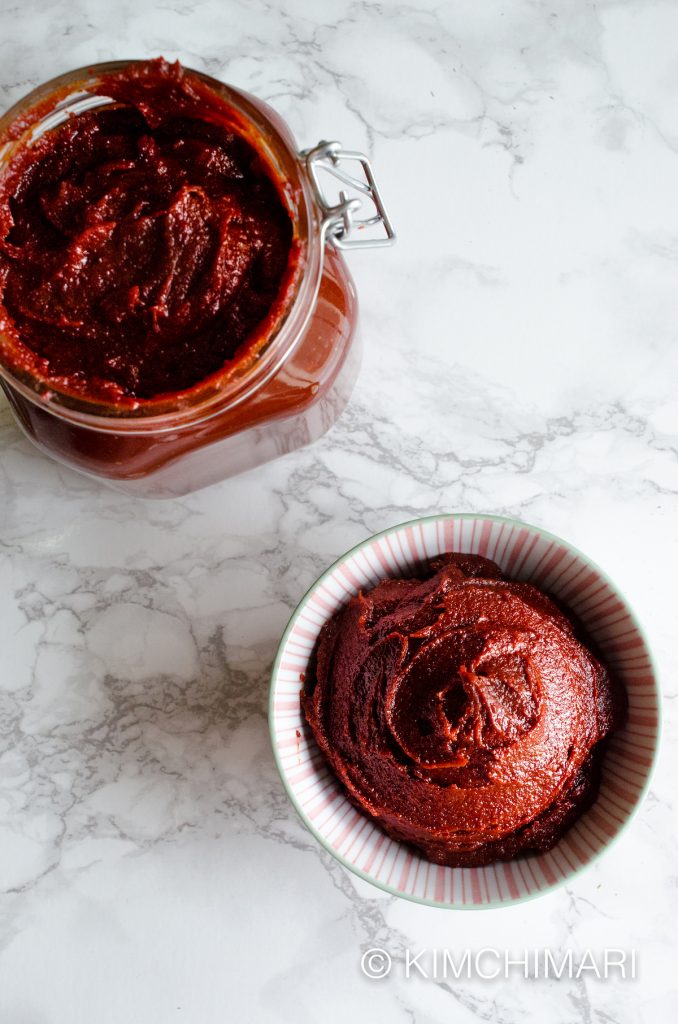
Homemade gochujang recipe that allows you to have a ready-to-eat gochujang in just a couple hours! What? That’s almost instant in the Korean fermentation world!! Is that possible?? Is it any good? You may ask… And my answer is YES and Yes, I mean, it’s pretty good considering it is ready in just few hours vs months.
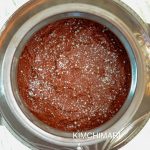
BTW, if you want to go all the way and make it the slow, traditional way using yeotgireum, try my very popular traditional gochujang recipe.
So I have to say I was pretty skeptical when I first learned this easy and quick homemade gochujang recipe from a temple food instructor Ms. Han a few years back while in Korea. I first met her while attending a temple food (sachal eumsik 사찰음식) class. Afterwards we kind of became friends… During class, she shared on how temple food helped her regain her health after having suffered with various health issues for so many years. Several years before, she said she was an art student in Italy and because she was so busy with her studies, she did not even have time to grocery shop properly let alone cooking for herself. So she said she ate just canned and instant foods all the time. Little by little, her health started to deteriorate with skin issues and other stomach issues. Things got so bad that she had to give up her studies and come back home to Korea. After coming back to Korea, she tried everything to cure her illnesses but nothing really helped until she decided to totally change her diet and went fully into temple food. She said after 6 months or so of cooking and eating temple food, her health slowly got back to normal and now, although she still has sensitive skin, she told us that she has no other health issues. So, naturally, she became a fan of temple food!
In 2014, when I opened my cooking studio in Seoul, she shared this easy and quick ready-to-eat gochujang recipe as a gift to me. And I was recently reminded of this recipe while I was making my gochujang for this year. I know this instant homemade gochujang recipe will never have the complex flavors that my authentic gochujang recipe (also on my blog) will develop over time but I know that this easy homemade gochujang recipe is still much better than the store bought ones – both in terms of flavor and health (no corn syrup and very little gluten).
The main difference between the two recipes is the milled malt barley. This quick and easy homemade gochujang recipe does not use any milled malt barley but just uses Korean rice syrup (jocheong 조청). But jocheong is made from rice and milled malt barley (yeotgireum 엿기름) so in some ways we are not going too far off the original recipe.
BTW, when I say ‘quick’, I mean quicker than my original recipe. 2 days + months of fermentation VS 2 hrs + few days of fermentation (optionally).
So here’s how you can make your own –
EASY HOMEMADE GOCHUJANG RECIPE
Makes: 4 cups Total Time: 2:40 hrs (Active: 40 min) Difficulty: Easy
Ingredients (** you can buy all the needed ingredients from my store – see Fermentation category)
- 2 C Korean gochukaru for gochujang (fine chili powder for gochujang) 고운고추가루
- 1.5 C meju powder (fermented soybean powder)
- 1/2 C sweet rice flour
- 1/2 C sea salt
- 1 C rice syrup (jocheong)
- 3.5 C water
- 1 Tbs green plum syrup (maesil cheong) – optional
- soju or sake – optionally if too thick
- In a pot (preferable flat bottomed and uniform sides), mix water and sweet rice flour. Mix it well with a whisk. Bring to boil, stirring often to prevent any lumps from forming and to make a paste. (much like sweet rice paste for kimchi)
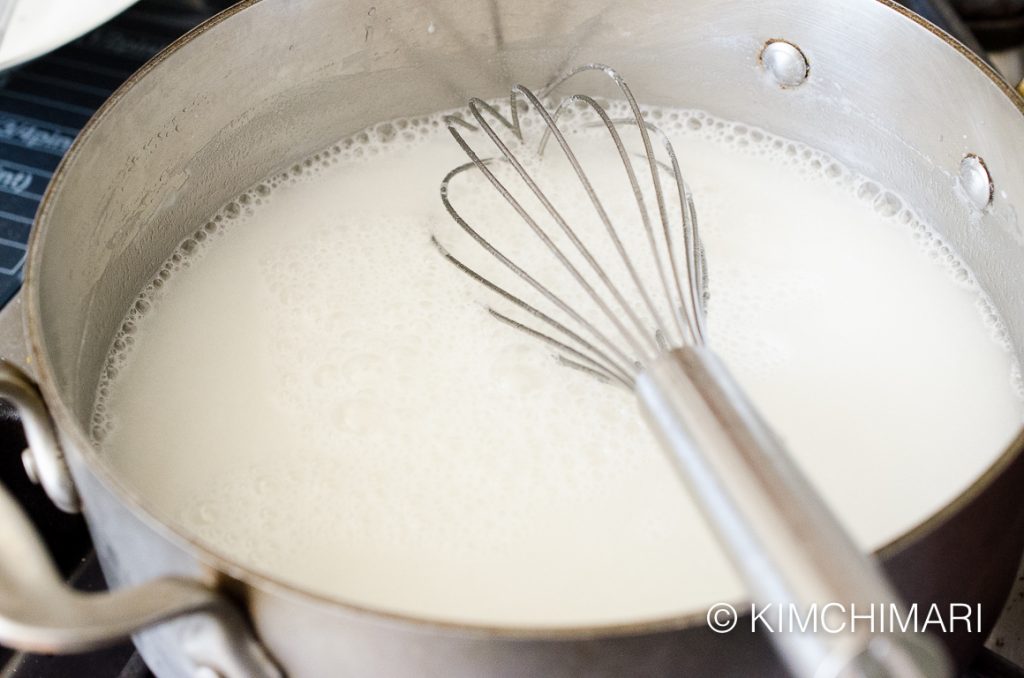
sweet flour and water in pot for gochujang - When it starts to boil, reduce heat and simmer for 10 min. or so until it is fully thickened to a paste. Stirring often to avoid lumps.
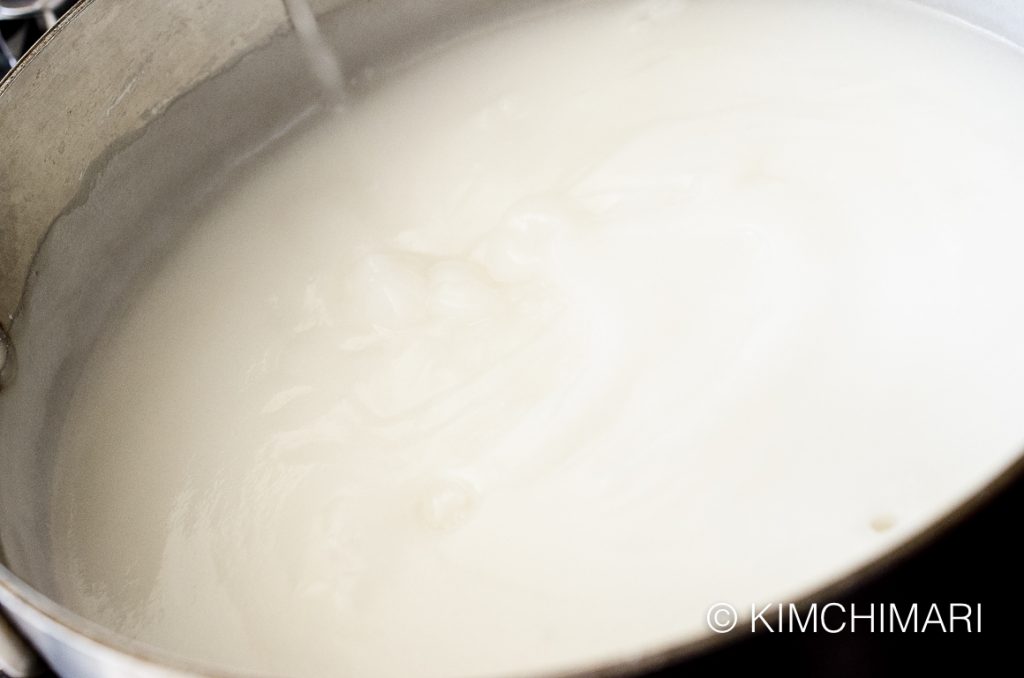
sweet flour paste for gochujang - Add 1 cup rice syrup to sweet rice flour paste and mix. You can add more if you want a sweeter gochujang.
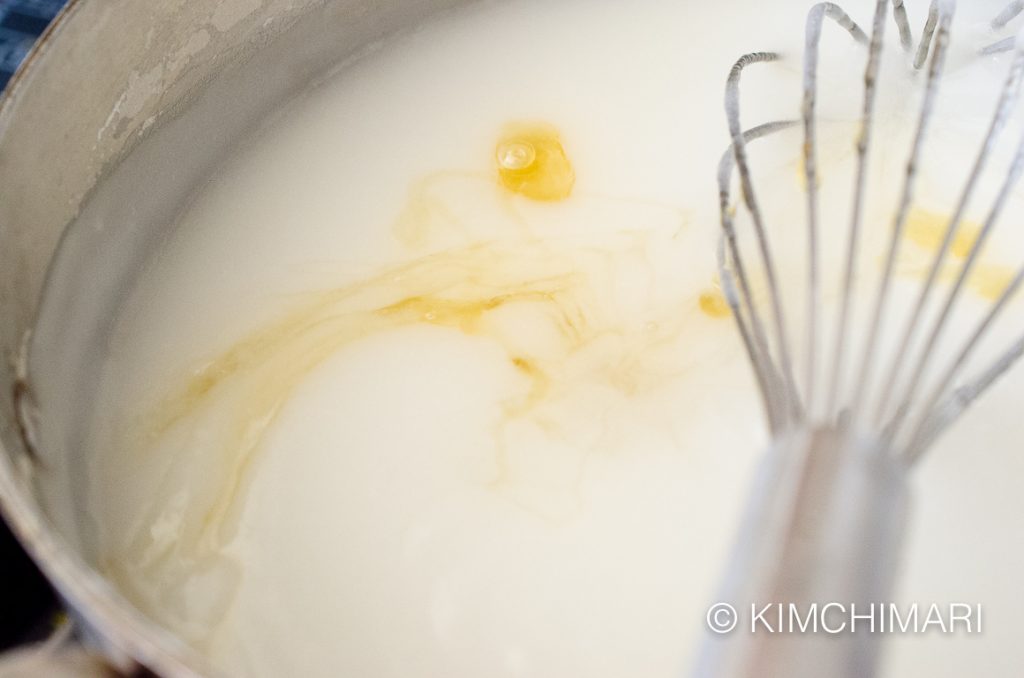
rice syrup in sweet rice paste Once you mix the syrup, the paste will become watery, no longer thick. That’s fine. Just continue to simmer for another 20-25 minutes until the volume reduces about 20%. Tip – you can measure the 20% reduction of liquid by using a chopstick to measure the height of the pot at the beginning and throughout. So if the height was 10 cm to start, you can stop when it is 8 cm. Note this will work only if you have a pot that is uniform in shape i.e. the diameter of the bottom and top of the pot is the same.
- Turn off heat and let it cool.
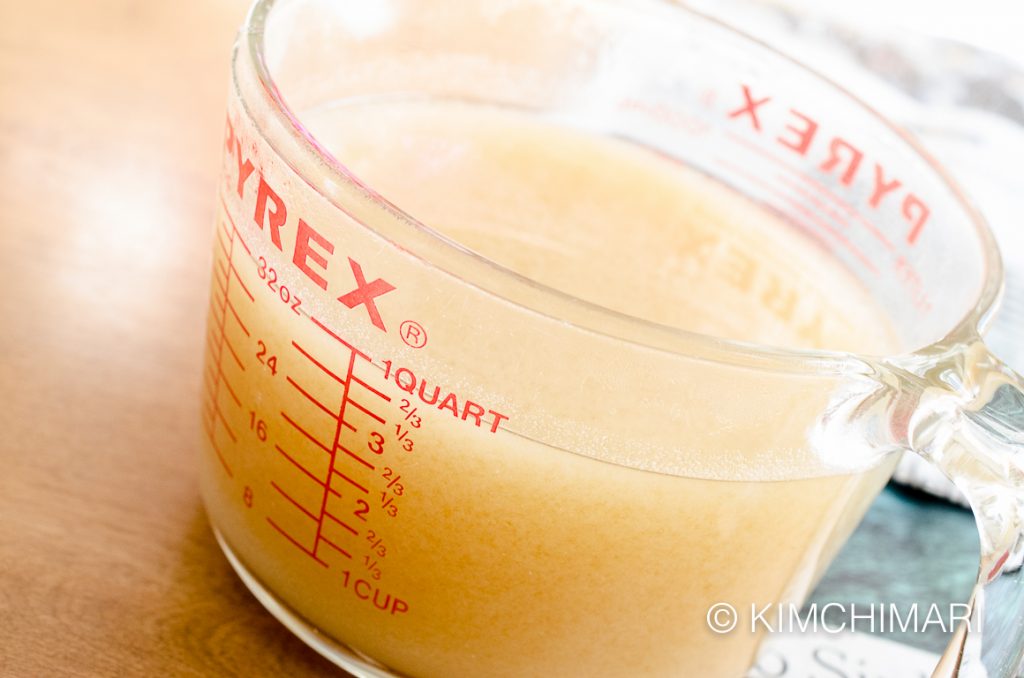
rice syrup sweet flour liquid for gochujang recipe Cooling time will be different based on your room temperature but for me it took about 2 hrs to cool the rice paste + rice syrup mixture from 3. It doesn’t have to be cold, just room temp. I transferred it to this glass measuring cup to cool it more quickly. You can always cool it in the fridge or in an ice bath to shorten the cooling time.
- Add meju powder, chili powder and salt to cooled rice syrup liquid.
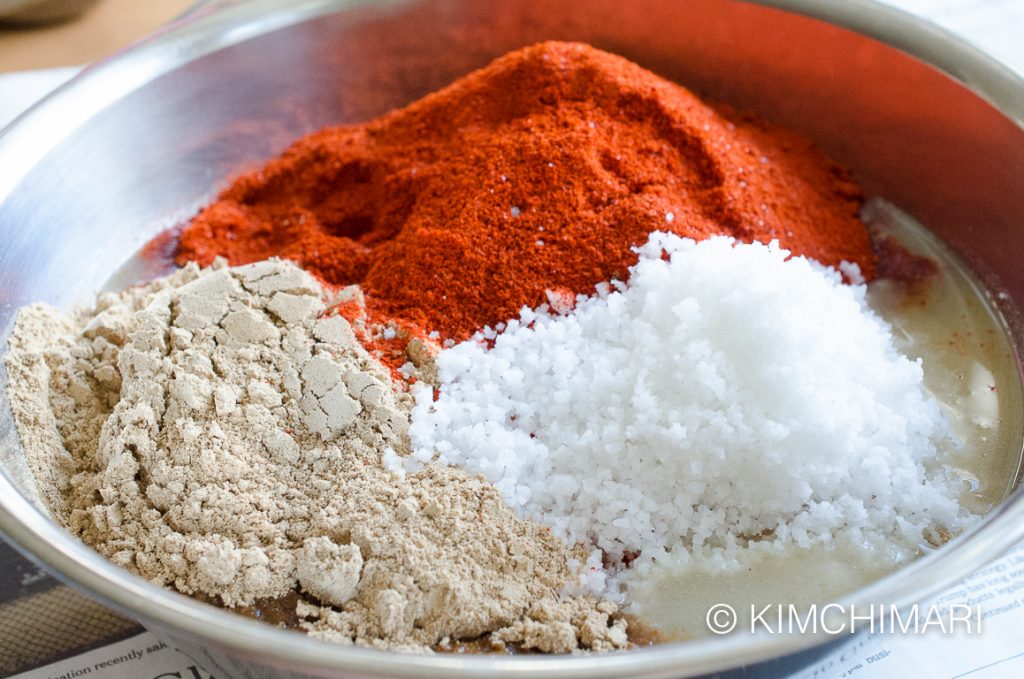
meju chili powder salt for gochujang - Use a whisk and mix everything well until there are almost no lumps.
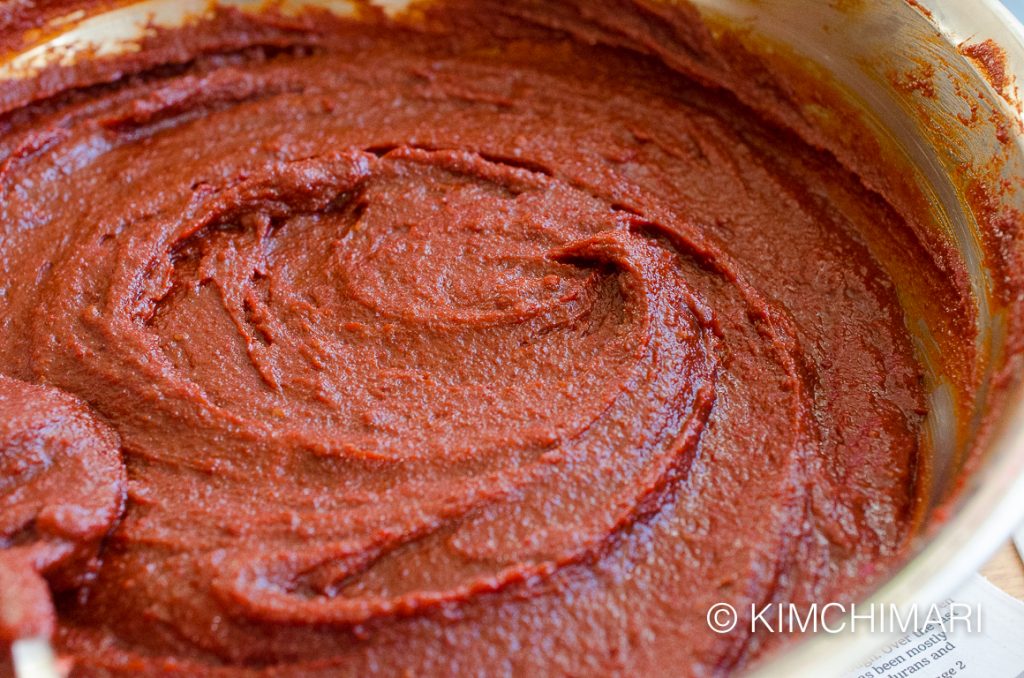
easy gochujang recipe mix - And there you go! You now have instant gochujang that you can use right away!!
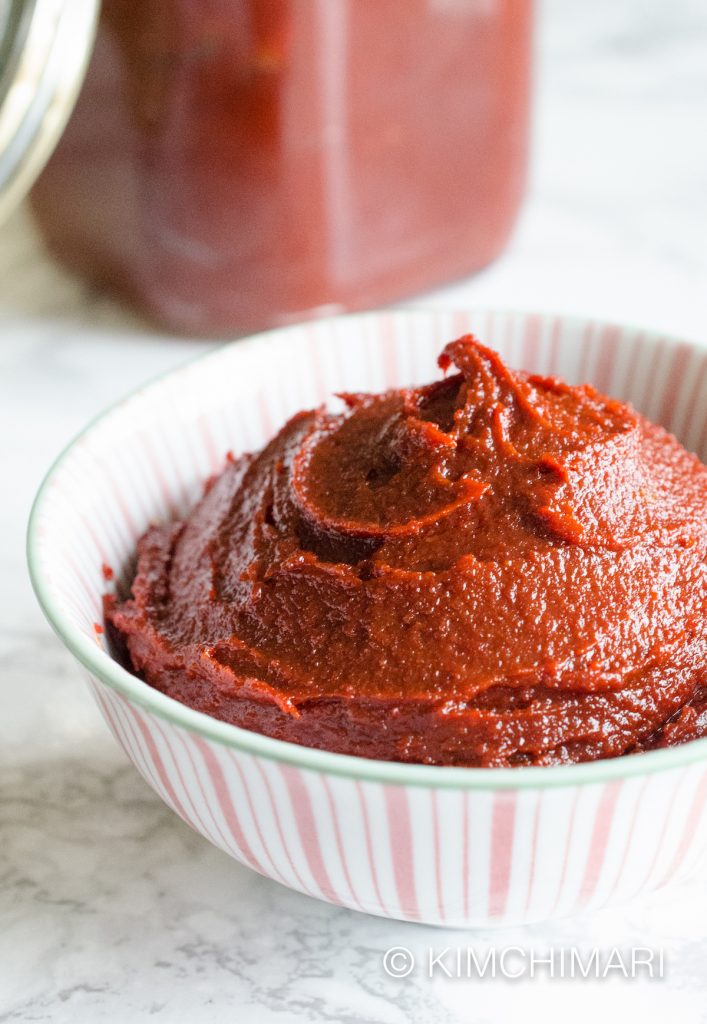
Easy Homemade Gochujang Recipe
Easy Homemade Gochujang Recipe That’s Almost Instant!
Ingredients
- 2 C Korean gochukaru for gochujang (fine chili powder 고추가루 for gochujang)
- 1.5 C meju powder (fermented soybean powder)
- 1/2 C sweet rice flour
- 1/2 C Sea Salt (Trader Joe's)
- 1 C rice syrup (jocheong)
- 3.5 C water
- 1 Tbsp green plum syrup (maesil cheong) – optional
Instructions
- In a pot (preferable flat bottomed and uniform sides), mix water and sweet rice flour. Mix it well with a whisk. Bring to boil, stirring often to prevent any lumps from forming and to make a paste. (much like sweet rice paste for kimchi)
- When it starts to boil, reduce heat and simmer for 10 min. or so until it is fully thickened to a paste. Stirring often to avoid lumps.
- Add 1 cup rice syrup to sweet rice flour paste and mix. You can add more if you want a sweeter gochujang.
- Turn off heat and let it cool.Cooling time will be different based on your room temperature but for me it took about 2 hrs to cool the rice paste + rice syrup mixture from 3.
- Add meju powder, chili powder and salt to cooled rice syrup liquid.
- Add meju powder, chili powder and salt to cooled rice syrup liquid.
- Use a whisk and mix everything well until there are almost no lumps.
- Let your gochujang mature a little more for 2-3 days in the fridge or at cool temperature before using it for even more flavor.
Tips & Notes:
- This is NOT the traditional gochujang recipe where it's meant to ferment for months outside in the sun. This is meant to be consumed pretty quickly and will not change much in flavor over time and may not last very long (i.e. will not have the deep ripened flavor)
- Buy special fine chili powder that is made specifically for gochujang (고추장용) or grind it very fine, like ground black pepper.
- It is important that the rice paste is cooled (not cold but room temp). If you add meju powder to hot liquid, the smell of meju powder will be too strong.
- If gochujang mixture seems to be too thick, you can add 1-3 Tbs of sake or soju. Mine came out a little on the thick side - I like mine that way.
- If you have maesil cheong (green plum syrup), you can add 1-2 Tbs for added flavor and sweetness. Now, you have Maesil flavored Gochujang. You can make your own maesil cheong or buy it. Substitute corn syrup or Oligodang syrup instead if you can't get maesil syrup.
Nutrition Information:
Notes
- This is NOT the traditional gochujang where it’s meant to ferment for months outside in the sun. This is meant to be consumed quickly.
- Buy special fine chili powder that is made specifically for gochujang (고추장용) or grind it very fine, like ground black pepper.
- It is important that the rice paste is cooled (not cold but room temp). If you add meju powder to hot liquid, the smell of meju powder will be too strong.
- If gochujang mixture seems to be too thick, you can add 1-3 Tbs of sake or soju. Mine came out a little on the thick side – I like mine that way.
- If you have maesil cheong (green plum syrup), you can add 1-2 Tbs for added flavor and sweetness. Now, you have Maesil flavored Gochujang. You can make your own maesil cheong or buy it.
Well, I hope you enjoy this easy gochujang recipe!
XOXO,
JinJoo
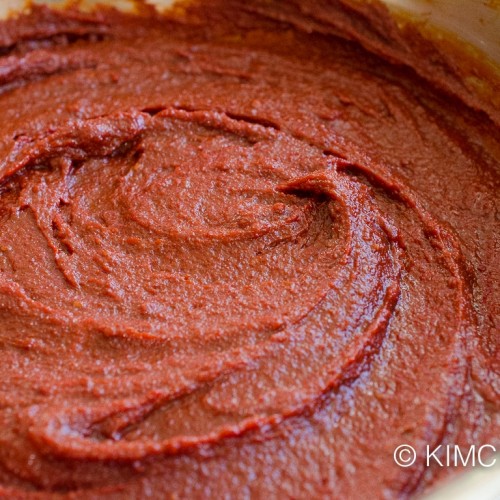
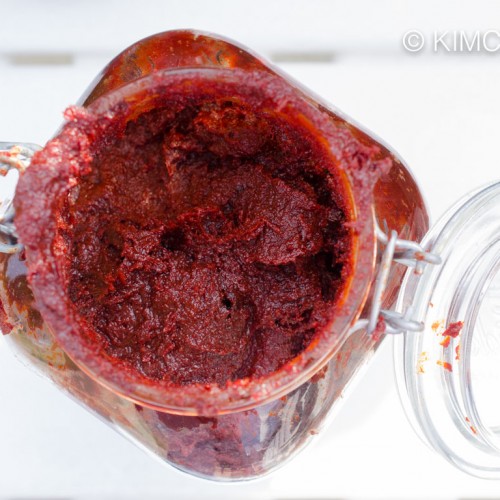
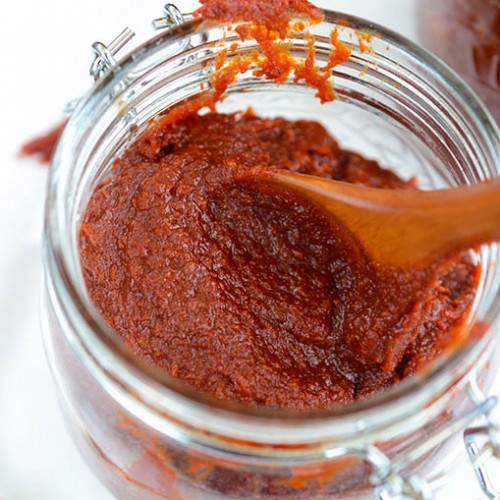

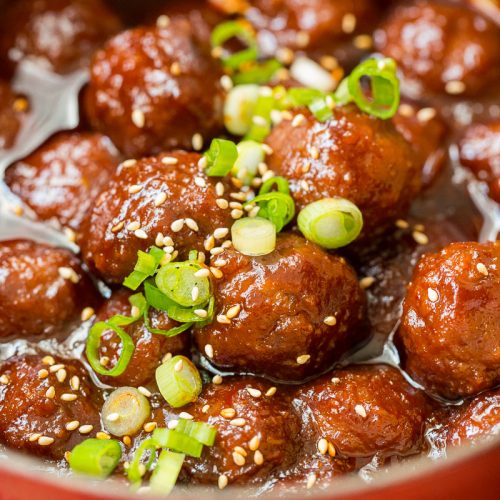
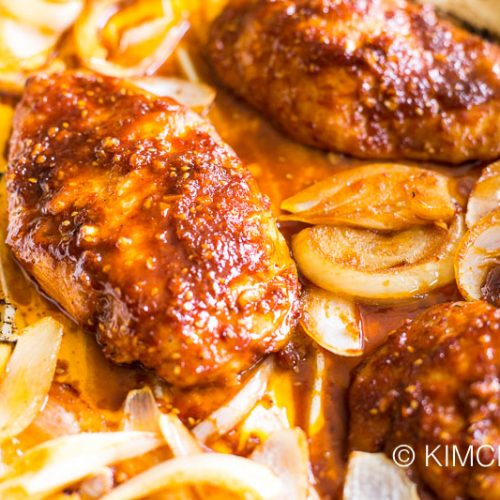
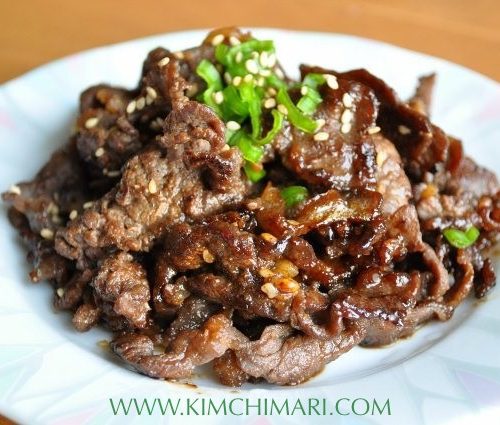
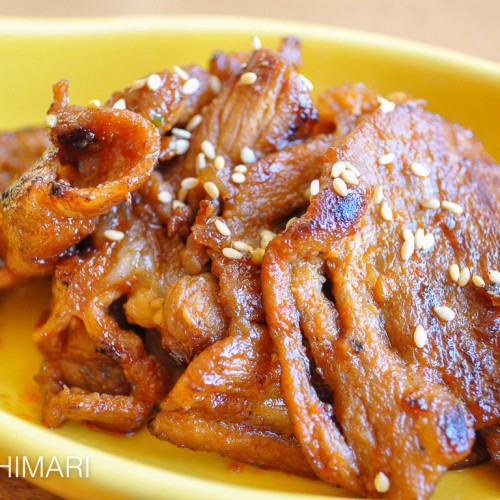
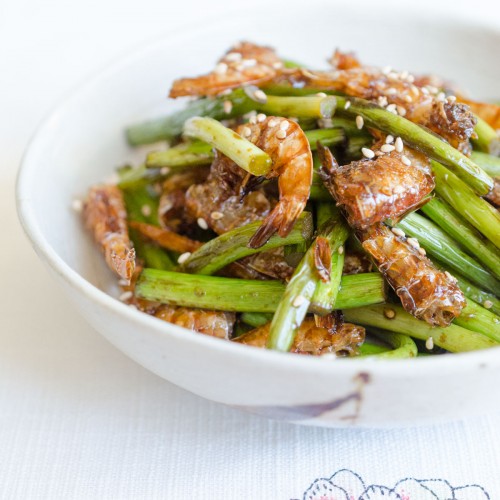
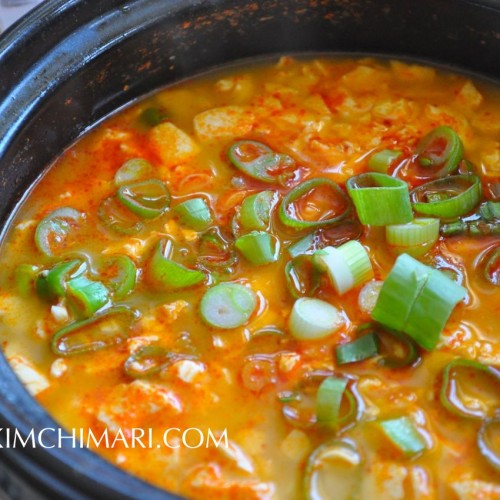
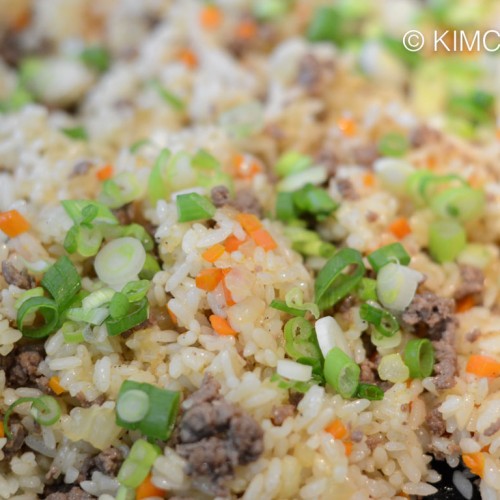
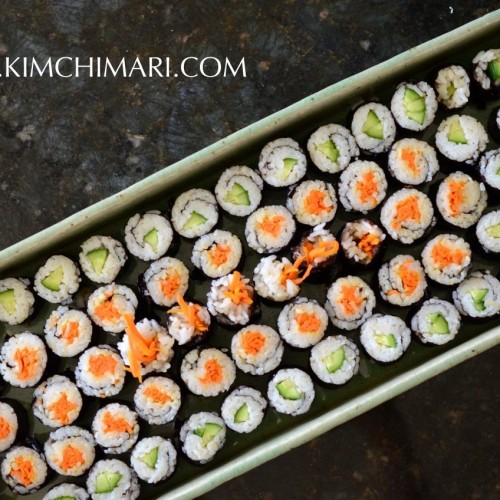
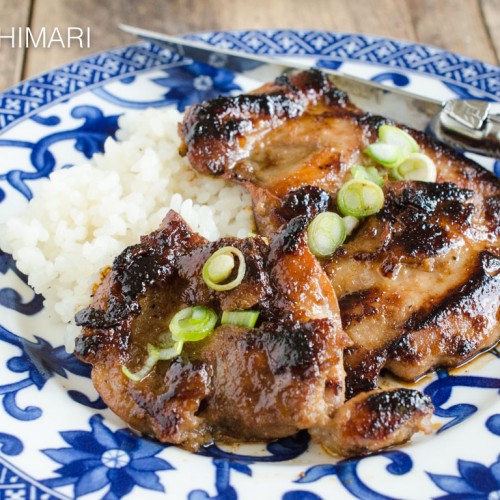
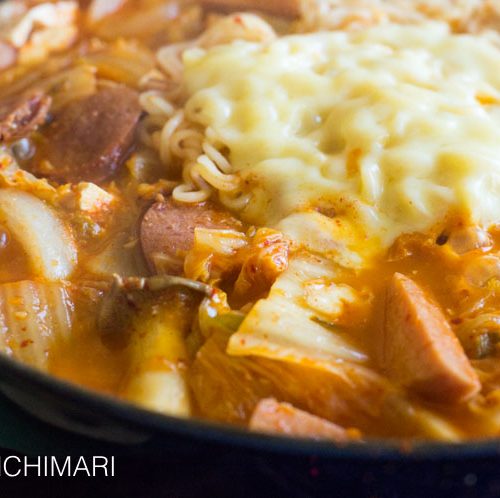
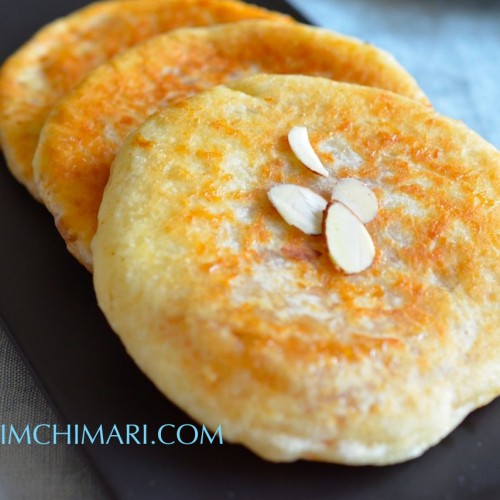






can i substitute miso paste for meju powder?
Although I have not tried it myself I have heard of people doing it. I would say to make sure you adjust the salt content since miso is quite salty. Good luck and would love to hear how it comes out!
Is there a good way to vary how spicy/hot one can make the gochujang?
Sure! The spiciness of gochujang all depends on how spicy the red chili powder is. Koreans either make it with less spicy powder from chilis having about 1000-2000 SHU (Scoville Heat Units) or mixing in the less spicy with more spicy (4000-7000 SHU) pepper powder. The spicy pepper powder is similar to Jalapeno spicy level. You cannot really reduce the amount of chili powder used but you can vary by choosing a less spicy chili powder or adding a bit more rice syrup should you need to. Hope that helps!
That does help, thanks! But what I really want to do is make if more spicy. I’ve spent some time in Korea and really love the food (especially the spicy foods) and I’ve found that gochujang can enhance the flavor of many non-Korean foods. I’m also looking forward to making some teokbokki.
OH! Got it! Soo.. if you can get it, buy gochukaru made from Cheongyang Gochu (청양고추)and mix that in with the regular gochukaru. Cheongyang Gochu is the one that makes it really spicy. I totally know what you mean – gochujang does enhance many foods that are not Korean. I will be sharing a post of some of my favorite recipes that use gochujang so stay tuned! And I just posted a gochujang pancake recipe. I hope you are following my blog. 🙂
PS-I want the best flavor possible but I also NEED it to be gluten free. Thank you!
Chungjungone is one of the few gluten free ones. But for the best flavor possible is hands down the home made kind. The store bought ones really does not have the true deep funky doenjang like funky flavor. But practically speaking this really makes a difference if you are going to enjoy its full flavor by making gochujang jjigae, tteokbokki or the taste difference matters to you and basically eating lots of it. The commercial ones will be sweeter and taste like siracha sauce minus the sourness. Hope that helps.
Hi JinJoo-How would you compare the quicker (instant) one to your traditional recipe in depth of flavor etc.. I just don’t want to be missing that certain taste when I use it in recipes. I’m looking to make a Korean rice bowl (Dolsot Bibimbap) and also a sauce for chicken wings. I think I will not buy the linked brand after your advice. I could just use sriracha if that’s the case. Also, the link to your store is not working. I clicked on it so I could buy some of the ingredients and you would get credit. Would it matter if I sought out organic ingredients where possible if I were making your instant recipe? I try to eat organic when possible. Thanks so much!
Well, Thank you so much for trying to buy the ingredient through my site. Amazon has done away with the store and now I have to setup a new one. So I was merely trying to compared it to Siracha to make a point about the difference in flavor. I definitely think even the commercial gochujang has much more flavor than Siracha…Siracha totally does not have any earthy, deeper flavor which gochujang does. AS for the difference between instant recipe and the full version, again, there’s a big difference in depth of flavor. And if you were to compare between the instant and the store bought, the instant one would still have more flavor but it may not be as huge. Sure, organic ingredients will work great always.
Hello! I was wondering how the Chung Jung One brand that you link to on Amanzon compares to the ‘instant’ (quicker!) one here? I read in your other post (the one where it takes a few days to make it) that you said the Chung Jung One brand is not complex and fermented like the Korean ones but still okay. So I’m just wondering if I’m doing myself any favors by trying to get all the ingredients together and make this one or if I should just buy that one. Is one better than the other? If this one has a little more complex flavor than the one I can purchase then it might be worth it but I’m just not sure. I’m really enjoying looking around here and just love everything you have to say! Thank you so much in advance!
Hi
Thank you for posting the recipe, it looks delicious and i can’t wait to try it.
I live in the U.K. and have found it a little tricky sourcing the ingredients.
I ordered from hmart but it seems they have the fermented powder incorrectly advertised on the website because the product is a paste!!
Before I contact them about returning it I just wanted to check if the recipe could be altered to incorporate the paste instead of powder?
Many thanks
Steven
HI Steven, So I guess you mean you got a Soybean Paste (Doenjang) instead? Although I have not tried making it myself, I have heard about making gochujang from doenjang. you can try my recipe but substitute sweet rice flour mixture + meju powder amount by doenjang, reduce the salt amount (since doenjang is already salty) and add a bit of soju. Also did you get FINE gochukaru? If you don’t use fine chili powder, you will end up with gochujang that is rough. Leave it at room temp for a week or so and then store in fridge. If you decide to try it, I would love to hear how it turns out for you. Good luck and thanks for asking!
Hi
Thanks for getting back to me.
Yes it’s the paste. If I substitute this for the powder and flour then do I boil the paste with the water in the first step or do i just add the rest of the ingredients to the paste?
I have got the corse chilli but I will grind it to a fine powder before adding.
I appreciate your help.
Oh yeah, sorry I forgot about that part. so you should mix the paste with either just water (do not boil) or make a vegetable stock from dried shitake mushrooms and onions of the same water amount and then mix with paste first. Then mix in the rest. Adjust overall consistency with soju and malt syrup. Don’t worry too much about the consistency. You can have thicker or thinner gochujang, not a big deal. Do taste it though – it should taste pretty close to the end product, just missing the more complex, deeper umami taste and the raw flavor of the chili stronger. Good luck!